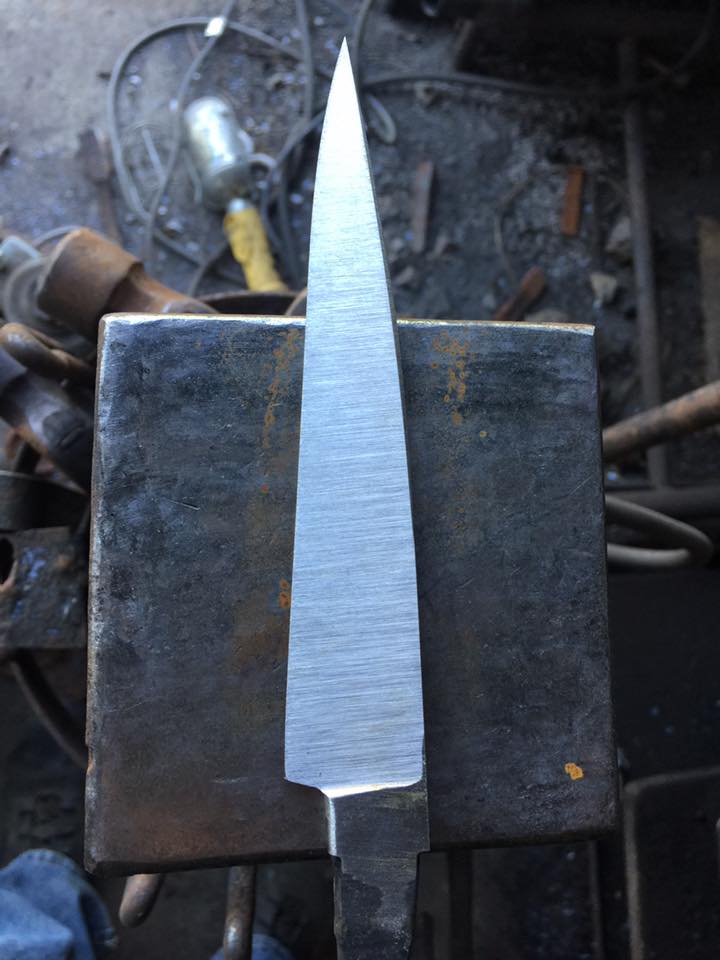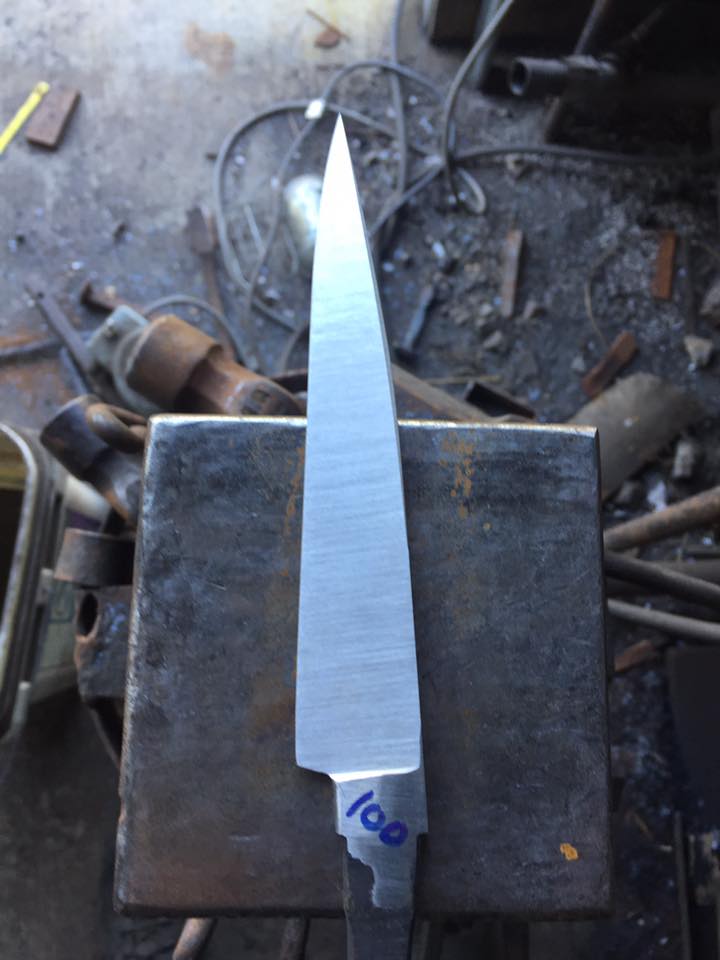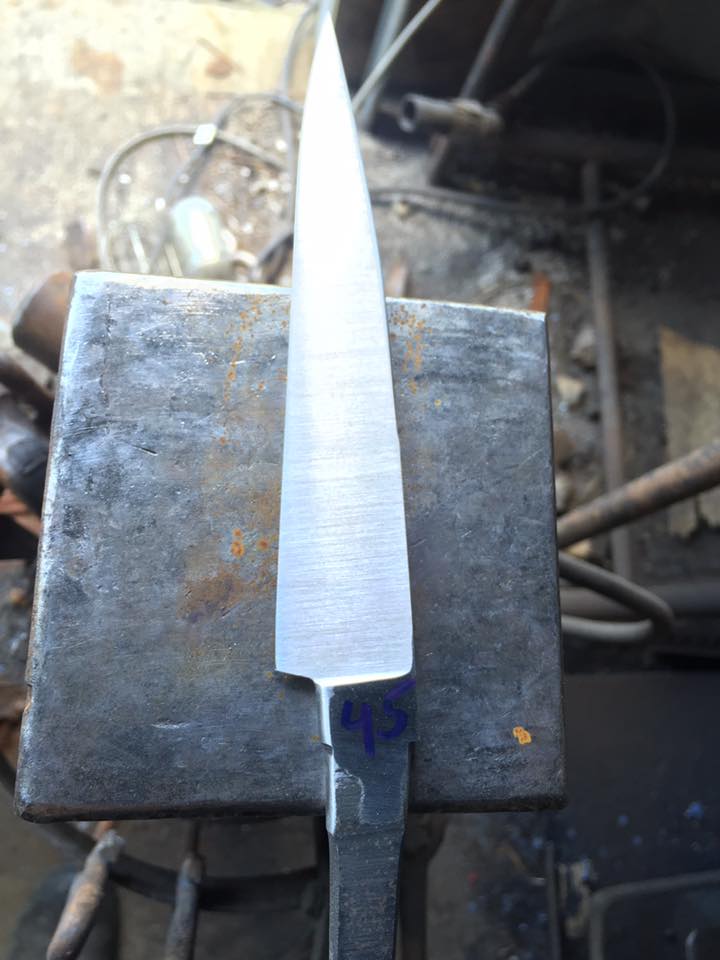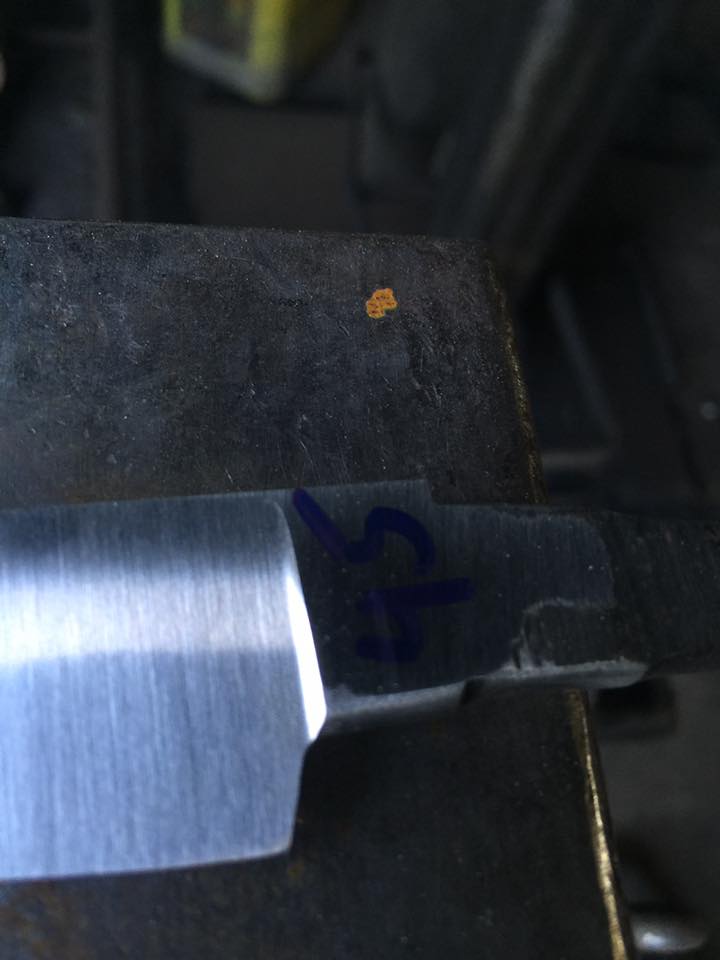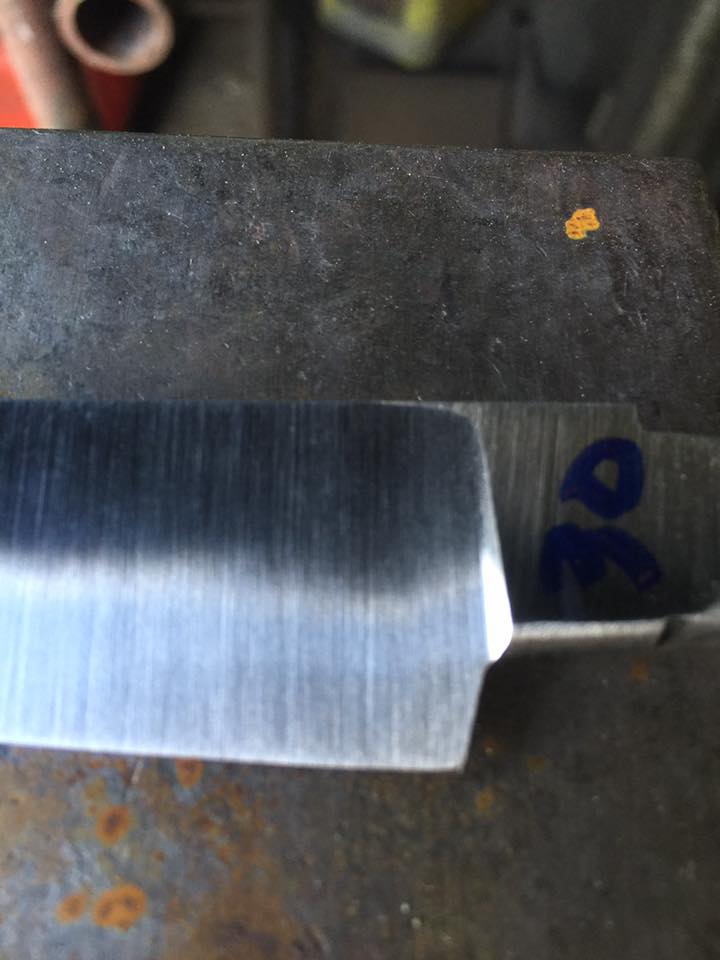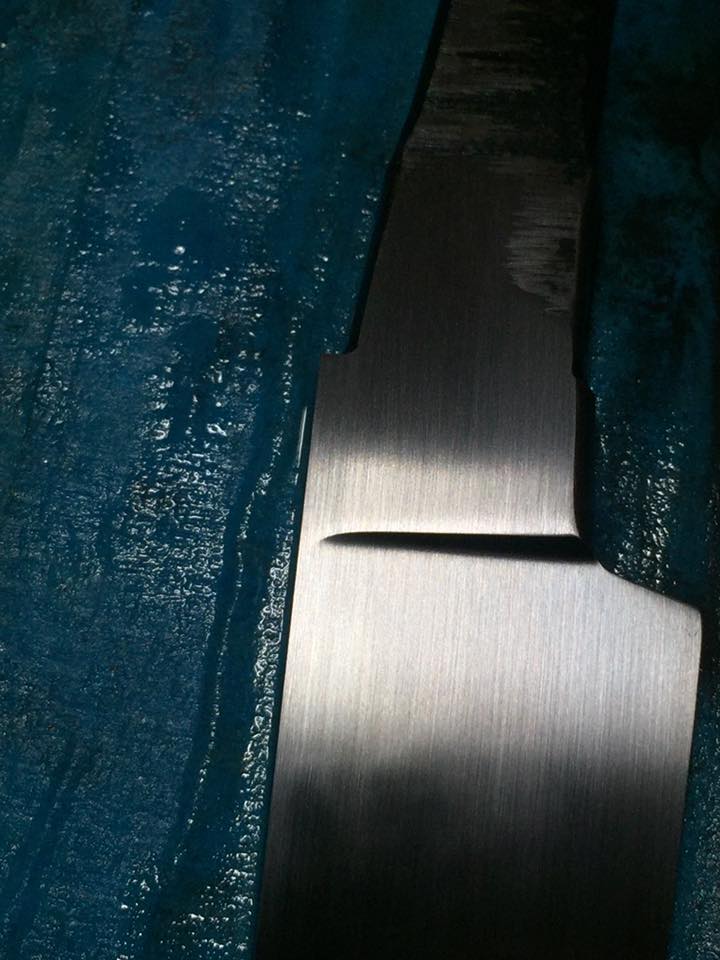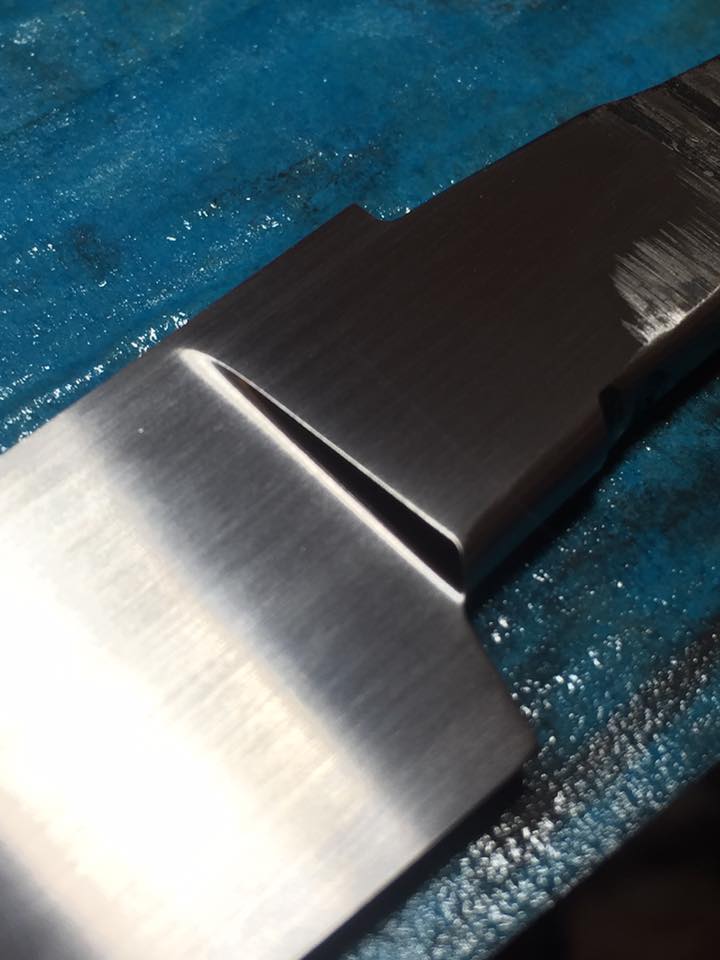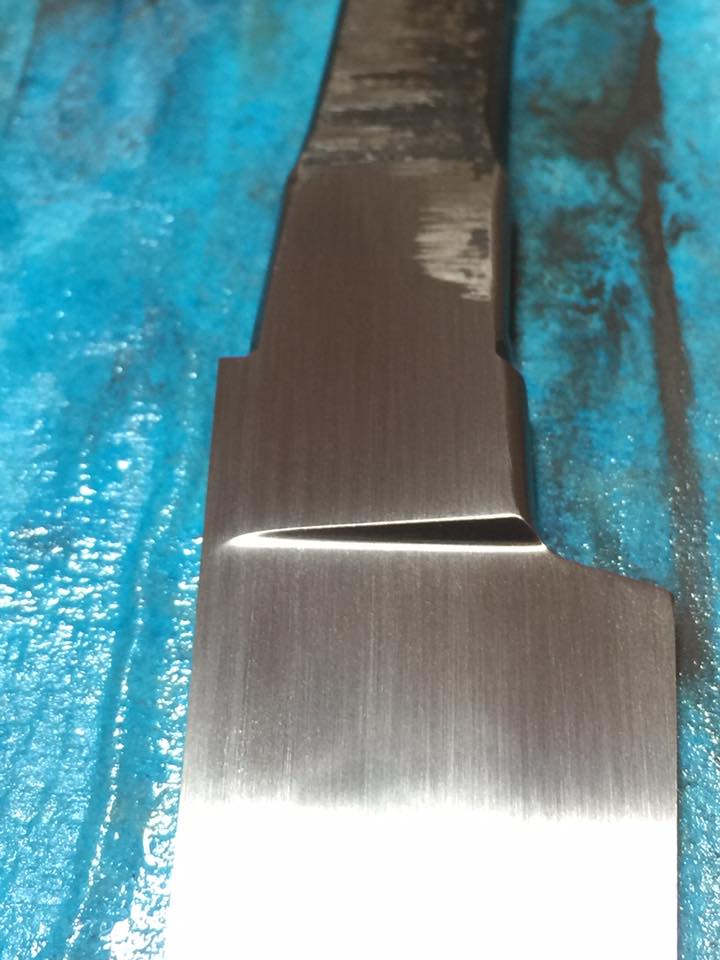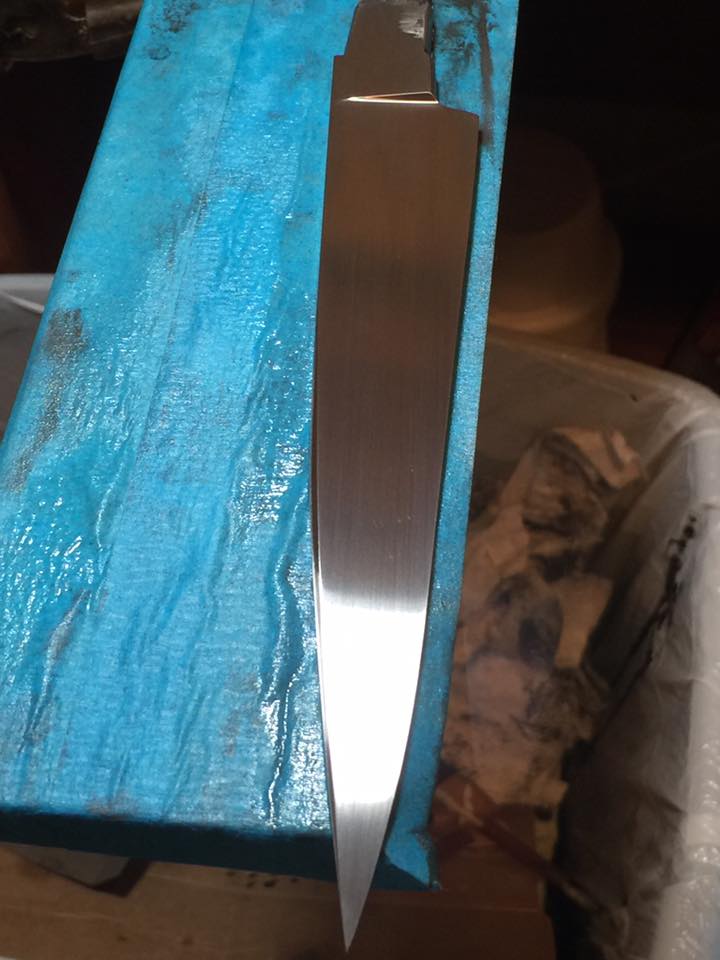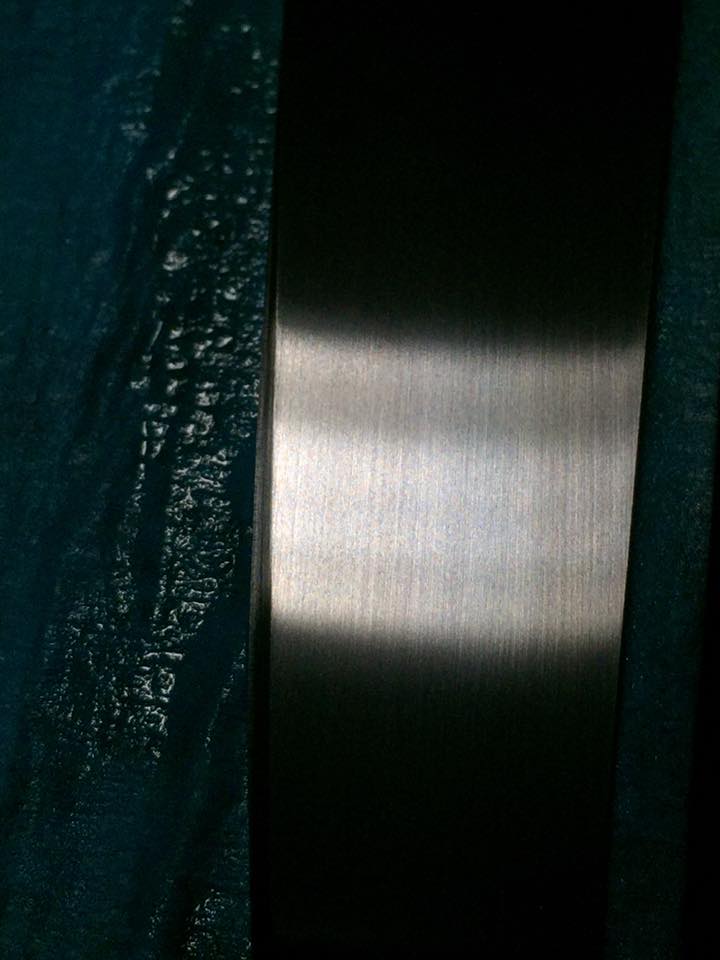This is really two questions in one.
I have a variable speed machine with a 3 horse motor.
So I can slow down and still not bog the machine.
When we start our grinding we are using a heavy weight low grit 36 or 50 at high speed.
The belt contours a certain way over the platen, which appears to me that the sides ride higher than the center.
As we move from the low grits, lets say under 100 to 120, 220, 240 etc. What kind of speed should we be using?
Also as the grit gets smaller the belt even if it is still an X weight belt the way it rides on the platen has changed.
This in turn, for me means that the flat I ground with a 36 or a 50 when it hits a 120 doesn't make full contact from the edge to the top of the plunge.
Any help with that would be great.
Beyond that at what grit do we slow our machines down to a crawl for a final polish before hand sanding.
For instance if I use a 36 to rough and jump to an 80 for cleaning up the 36 and then move to a 120 to try to even out, set plunges etc. am I still running the same speed?
I jump to Trizac belts from there going through the grits from A60-45-30 which approxamates as 240,400ish, and 600.
Should I be running these slower and slower?
Again these belts, the trizacs countour the platen differently than the X weight belts and seem to be contacting the face of the blade differently.
Would it be better to just go from an A300 through the trizac grits after finishing up with an 80 grit X weight belt?
Beyond that, for the people who use light weight belts on a platen. How do you manage that?
Welcome to the challenges of knife making.
It ain't a perfect world.
And to confuse things even more - when going from two belts exactly same, they may travel/cut differently.
The best you can do is buy the highest quality belts you can afford. There is a difference. "Economy" belts will give you an 'economy' grind.
One thing I have noticed is that different types belts react differently to the tracking wheel. With the slight crown on many tracking wheels the center of the belt actually gets stretched because it's traveling over a 'longer' distance, and this is noticed when it hits the platen.
The platens make a difference.
Everything is a variable.
Even in the best situation you can possibly provide, a 'flat' ground knife is never truly flat.
After I get my knife mostly ground I go to my disc sander - which is flat. After just a couple seconds on the disc sander it displays how not-flat the blade really is.
Your challenge as a knife maker is to find the recipe of belts/grits/methods that you can come up with in your shop that ends with the best result.
it doesn't happen over night.
This is where many times we separate the "men from the boys".
Basic rule for most is the higher the grit - the slower the speed. Grit types may alter this some as well as belt configuration.
I don't mean to discourage you but for many makers, it takes years - and years - of shop time to get to a point where they are in control of their knife building.
It truly is a never-ending process.
"Slower = better. Better = faster"
Karl B. Andersen
Journeyman Smith
Thanks Karl.
I appreciate the candid reply.
It has been my assumption for a while that "Off" the platen a knife is never truly flat.
I had a 1 degree disc and really didn't like using it so I gave it to another knifemaker.
I have considered that hand polishing with my hardest backer before heat treat would be wise, however, any issues of decarb would mean I have to go back to the grinder before polish.
I could of course use anti scale but that in itself can leave some unwanted spots that still have to be dealt with.
I rarely use 36 grit except to clean the scale off or to shape some handle blocks. I start at 60 and leave some material to allow me to remove the scratches with the succeeding grits. I work at higher but appropriate speeds when the belts are new and sharp because they run cooler.
If you tend to get ripples or your belt cuts deeper on the edges than in the center, you might need to dress your platen. A new belt on a truly flat platen makes a world of difference. Also due to grinding habits, the tendency is for the belt to wear more in the middle which will not translate into a flat grind.
Karl described the grinding dilemma very well. Some days things work very well and some days it just fights you. I think part of this is due to the fact that our "flat grinds" are really not flat grinds in the exact sense. We have to warp and skew our flats to suit the blade length, taper, and profile. When I grind a blade whose shape and style is different, I may have to get a feel for it before things go right.
Lin, that is also a candid and helpful perspective.
I hog the hell out of stuff with a 36 and then jump to whatever I choose next or may have. Usually an 80 or a 120.
Your comment about warping and skewing a flat is interesting.
My grinding habits tend to be pull off.
i work pretty flat to the platen which is a custom build, very tall and machined flat, but I tend to pull the tip into the platten.
I end up with pretty dramatic distal tapers but again, it is not truly flat and tends to have a bias to one side. Strong or weak.
As both of you guys have said, its a challenge, and time and practice makes progress.
I am glad for the conversation about belt speed because its hard to tell if I should use for instance the Trizac Gators as fast as possible.
They will hold up to it but have no idea what the cut to control dynamic would or should be.
Would be interested to hear if anyone uses the tryzacs from 300 all the way to 30.
I would assume the geometry would have to be very well set and the edge to be down to almost finished thickness.
Thanks again for the responses.
So deciding to investigate and try to answer my own question.
I took a hardened blade.
That was ground to 120.
Started with and A300 and went through the grits A300,100,65,45,30
Each photo the blade has a number on it except for the first.
That first one is the 300 blade.
The 300, 100 and 65 were run about mid speed on my grinder.
I will attach a link to the video on Face Book but if you are not my friend you may not be able to view it.
Friend me if you want to.
The 45 and 30's were run very very very slow.
So slow the blade took no heat and did not need to be quenched.
So slow that if my hand bumped the belt it didn't cut or burn me.
The whole blade including the bottom of the ricasso and the plunge are polished via the belt.
This side is the strong side of my grind but I wanted consistency for the photos.
Next I will see if moving right to 500 rhinowet will take these marks out quickly.
Here's the link to the video
https://www.facebook.com/100009870520784/videos/259019844437031/
Thanks for looking.
All feeback is welcome.
I love the Gators - immensely. I use them on my platen, slack belt, and love them on my surface grinder.
When grinding, 36 - 60 984 ceramics, then straight to the Gators.
I don't even own any 120, 220, 320, etc. in any kind of normal grit belts. None.
If they quit making Gators I'd have to learn to grind knives all over again.
Karl B. Andersen
Journeyman Smith
Karl, what grit do you start hand sanding at after the Gators?
JJ, I'd like to go back to Karl's original suggestion about the disc sander. I pretty much only use ceramic 3M belts in the following grits: 60, 120, & 220. The 220 is only used during post-HT in finish grinding and then only minimally. The only Trizac belts I use are A45 to set the plunge cuts by bending the belt over the platen edge (at about 40% speed) and I'm moving away from that technique in favor of a different method. To remove the scale from the blade, I simply soak the blade in a solution of PH Down for a few hours. This is a dry acid made for pools and can be purchased at any home improvement store, most hardware stores (Ace or True Value), and Pool supply stores. I mix about 1/2 cup to 2 gallons of water. Pulls the scale off the blade pretty quickly. It's a lot less expensive than 36 grit ceramic belts.
Now about that disc grinder. A 1-degree bevel disc produces a shallow hollow grind and causes hand sanding to become a tremendous amount of work to return the blade to flat. A flat disc will produce a truly flat grind over the lion's share of the face. You will still need to "roll" the point area on the disc somewhat. Rough grind is 60 grit ceramics at fairly high speed (90-100%) followed by the 120 ceramics at a little slower. Then its onto the disc to straighten and flatten at 150 grit aluminum oxide around 75% speed. Then it's HT time.
Post HT, the flat platen at 60 and 120, set the plunge cuts and clean up with 220. Move to the disc at 220, 320, 400 pretty fast. Everything else after that is hand sanded. usually I can get away with starting my hand sanding at 320, but sometimes I have to go back to 220. hand sanding is done with 3M micron belts cut into 1" strips. 60m, 40m, 30m, (stop here or proceed to 15m).
I'm intrigued about those Gator belts, as I've never tried them. I just remembered that I sometimes also use the Trizac green belt (can't remember the #) on my surface grinder to prep the faces.
Joshua States
www.dosgatosforge.com
https://www.youtube.com/channel/UCdJMFMqnbLYqv965xd64vYg
https://www.facebook.com/dos.gatos.71
Also on Instagram and Facebook as J.States Bladesmith
“So I'm lightin' out for the territory, ahead of the scared and the weak and the mean spirited, because Aunt Sally is fixin’ to adopt me and civilize me, and I can't stand it. I've been there before.â€
Thanks for the Reply Joshua,
I also have a 9" flat disk that is in a disc grinder case.
I'm sure I could take the whole thing apart and bottom mount the motor through a table so I had clear access to the edge of the disk.
What do you do about the revers pull of the disc on a larger blade?
The primary reason the one degree discs were made was to stop that issue.
My hand sanding time is incredibly little, but I start at 220.
The disc sander is my friend. ![]()
|quoted:
Karl, what grit do you start hand sanding at after the Gators?
Karl B. Andersen
Journeyman Smith
|quoted:
Thanks for the Reply Joshua,
I also have a 9" flat disk that is in a disc grinder case.
I'm sure I could take the whole thing apart and bottom mount the motor through a table so I had clear access to the edge of the disk.
What do you do about the revers pull of the disc on a larger blade?
The primary reason the one degree discs were made was to stop that issue.
I have mine with the motor controller mounted to an aluminum plate that is attached to my workbench so that the disc hangs out past the edge of the bench top. I don't find the reverse pull to be much of an issue really. When I grind, I keep the blade edge up and focus on the downward side of the disc (this is why the motor needs to be reversible). The portion of the blade that is in contact with the upward side is generally the point area and this has a much smaller surface area than the portion on the downward side. It also should not be completely in contact with the disc because you have established a distal taper during the grinding on the belt. That distal taper naturally lifts the blade away from the disc.
During the grinding the blade spine rests on the side of your index finger of one hand with the thumb applying pressure to the blade face. The other hand is holding the tang and pulls the blade across the disc. The portion of the pointy end that was contacting the upward side is not in contact for very long during this operation.
Joshua States
www.dosgatosforge.com
https://www.youtube.com/channel/UCdJMFMqnbLYqv965xd64vYg
https://www.facebook.com/dos.gatos.71
Also on Instagram and Facebook as J.States Bladesmith
“So I'm lightin' out for the territory, ahead of the scared and the weak and the mean spirited, because Aunt Sally is fixin’ to adopt me and civilize me, and I can't stand it. I've been there before.â€
I uploaded to youtube the speed the machine is running on final grind.
And then turned the machine up all the way so you can see the difference in speed.
Taking this study further.
I wanted to see if I could start at 800 grit Rhinowet and in the time it took to make a frozen pizza I had everything but the plunge polished.
So from A30 to 800.
The only reason the plunge took longer is I didn't have a readily fitting block.
And had to improvise.
Very nice.
Karl B. Andersen
Journeyman Smith

